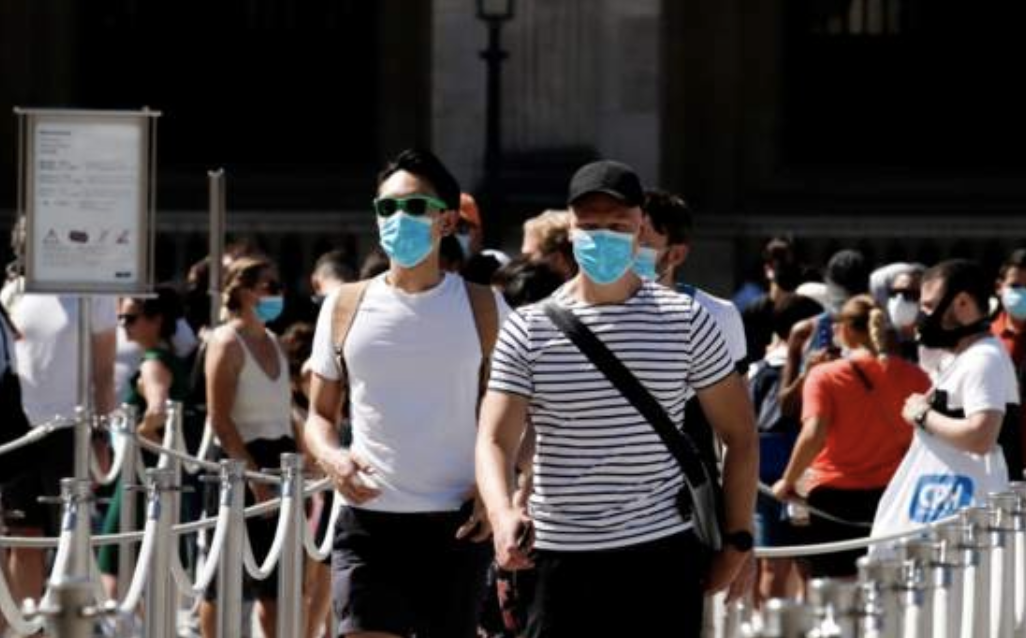Wearing Masks Outdoors Now Mandatory In Paris As WHO Warns “Majority Of World Still Susceptible” To COVID-19: Live Updates
Tyler Durden
Mon, 08/10/2020 – 08:24
Summary:
- World on the cusp of 20 million confirmed COVID cases
- Paris mandatory outdoor mask rules take effect
- WHO warns “majority of world still susceptible” to COVID
- Germany warns of “alarming” rise in new cases
- Former Indian president tests positive
- Situation in Pakistan improves as lockdowns ease
- Lebanon suffers worst jump in infections yet
* * *
As global confirmed COVID-19 cases near 20 million (with potentially millions more that were never catalogued), an uptick in new cases has inspired Paris officials to impose dramatic new restrictions involving mandatory mask wearing. Masks must now be worn in public, even outdoors.
The order was announced over the weekend. it applies to people aged 11 and over, and covers busy outdoor areas in the French capital and more than 100 streets, although tourist sites such as the Eiffel Tower, the Arc de Triomphe and Champs-Elysees boulevard are not included, as French politicians continue to extend concessions to the badly battered tourism industry.
As the BBC points out, the Paris mask rule is part of a trend of localized restrictions sweeping Europe.
The new mask rule in Paris is part of a pattern that is spreading across the country – indeed across Europe – as governments try to stamp down the new virus embers.
It has been obvious for weeks that in some much-frequented parts of the capital, keeping the one-metre (3.2ft) rule is a challenge.
On the Seine quays for example, walkers, joggers and cyclists brush past revellers at the many riverside bars.
Masks are already obligatory in France in all enclosed public spaces – including inside tourist attractions like the Louvre and the Eiffel Tower.
And across the country, well over 1,000 towns and cities have prescribed face coverings in certain streets and neighbourhoods.
The main target of the rules are young people who gather to enjoy the holiday and the sunshine.
All the evidence shows that they are the group among whom infection is growing fastest.
They may be at a lower risk of becoming seriously ill from the virus than older people. It is their role as vectors that is a cause for concern.
A top US health official has praised Taiwan’s response to the coronavirus pandemic, hailing it as “among the most successful in the world”, during a rare diplomatic visit to the island.
Elsewhere in Europe, Germany’s economy minister warned of an “alarming” rise in infections. “We need to flatten the curve and turn this around,” Peter Altmaier told German press as schoolchildren in Berlin return to classrooms for the first time in months. Germany has also seen its single-day case count top 1,000 for the first time in weeks.
With the world on the cusp of reporting 20 million confirmed cases of the coronavirus, the WHO delivered a stark warning during a Monday morning press briefing from Geneva: the majority of the world’s population remains susceptible to infection.
Dr Maria Van Kerkhove, famously the agency’s technical lead on COVID-19 research who once caused an uproar by declaring asymptomatic transmission a “rare” event, and seemingly undercutting the case for compulsory mask-wearing, told reporters on Monday that there was “no indication that there is seasonality with this virus” and urged people to do everything they could, including physical distancing, wearing a mask where appropriate and avoiding crowded settings, to prevent the spread of infection.
Media briefing on #COVID19 with @DrTedros https://t.co/gidl4jYpVR
— World Health Organization (WHO) (@WHO) August 10, 2020
Earlier, the WHO’s Director General Dr Tedros Adhanom Ghebreyesus praised the UK’s decision to take “targeted action” by imposing ‘partial lockdowns’ in parts of Leicester and parts of northern England.
Dr. Tedros told the briefing: “Strong and precise measures like these, in combination with utilizing every tool at our disposal, are key to preventing any resurgence in COVID-19 and allowing societies to be reopened safely.”
After crossing the 2 million mark last week, infections in India have slowed slightly as antibody surveillance testing suggests that some of the worst-hit slums in Mumbai and New Delhi have achieved roughly 50% infection rates, not far from levels where ‘herd immunity’ might come into play.
What’s more, on Monday, Pranab Mukherjee, India’s president from 2012-2017, has just announced that he has tested positive for the virus.
But the world’s second-most-populous country hasn’t had nearly as much success as its neighbor, Pakistan, where the outbreak has continued to wane as the country’s ‘partial lockdowns’ have been slowly unwound.
Here’s more on that from the BBC:
With restaurants, cinemas and tourist spots reopening (albeit with some restrictions in place) life in Pakistan is returning to “normal”.
Partial lockdowns have been in place since March, but have been progressively eased.
With just over 6,000 coronavirus deaths in a population of about 230 million, despite the country’s weak healthcare system, Pakistan appears to have fared far better than many in the West.
Finally, as anti-government protesters return to the streets, clashing with security forces, Lebanon reported its highest daily increase in coronavirus infections yet on Monday, compounding the country’s problems after a devastating explosion tore through Beirut last week.
Another 294 cases were recorded on Sunday, bringing the country’s total number of infections to 6,517, per health ministry data.
via ZeroHedge News https://ift.tt/3ikGT06 Tyler Durden
